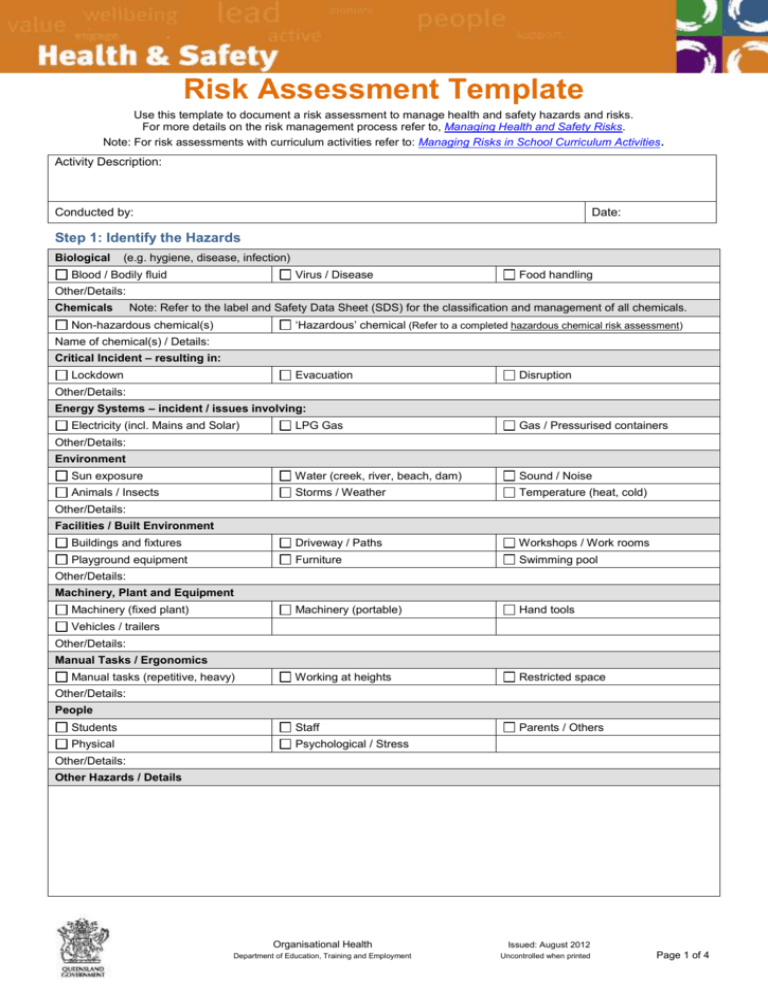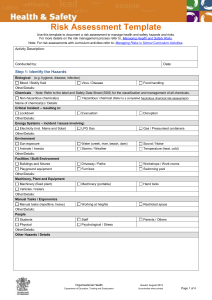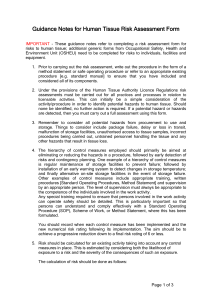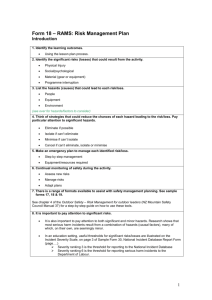Health and Safety Risk Assessment Template
advertisement

Risk Assessment Template Use this template to document a risk assessment to manage health and safety hazards and risks. For more details on the risk management process refer to, Managing Health and Safety Risks. Note: For risk assessments with curriculum activities refer to: Managing Risks in School Curriculum Activities. Activity Description: Conducted by: Date: Step 1: Identify the Hazards Biological (e.g. hygiene, disease, infection) Blood / Bodily fluid Virus / Disease Food handling Other/Details: Chemicals Note: Refer to the label and Safety Data Sheet (SDS) for the classification and management of all chemicals. ‘Hazardous’ chemical (Refer to a completed hazardous chemical risk assessment) Non-hazardous chemical(s) Name of chemical(s) / Details: Critical Incident – resulting in: Lockdown Evacuation Disruption Other/Details: Energy Systems – incident / issues involving: Electricity (incl. Mains and Solar) LPG Gas Gas / Pressurised containers Sun exposure Water (creek, river, beach, dam) Sound / Noise Animals / Insects Storms / Weather Temperature (heat, cold) Buildings and fixtures Driveway / Paths Workshops / Work rooms Playground equipment Furniture Swimming pool Machinery (portable) Hand tools Working at heights Restricted space Students Staff Parents / Others Physical Psychological / Stress Other/Details: Environment Other/Details: Facilities / Built Environment Other/Details: Machinery, Plant and Equipment Machinery (fixed plant) Vehicles / trailers Other/Details: Manual Tasks / Ergonomics Manual tasks (repetitive, heavy) Other/Details: People Other/Details: Other Hazards / Details Organisational Health Department of Education, Training and Employment Issued: August 2012 Uncontrolled when printed Page 1 of 4 Step 2: Assess the Level of Risk Consider the hazards identified in Step One and use the risk assessment matrix below as a guide to assess the risk level. Consequence Likelihood Insignificant Minor Moderate Major Critical Medium Medium High Extreme Extreme Likely Low Medium High High Extreme Possible Low Medium High High High Unlikely Low Low Medium Medium High Rare Low Low Low Low Medium Almost Certain Consequence Description of Consequence Likelihood Description of Likelihood 1. Insignificant No treatment required 1. Rare Will only occur in exceptional circumstances 2. Minor Minor injury requiring First Aid treatment (e.g. minor cuts, bruises, bumps) 2. Unlikely Not likely to occur within the foreseeable future, or within the project lifecycle 3. Moderate Injury requiring medical treatment or lost time 3. Possible May occur within the foreseeable future, or within the project lifecycle 4. Major Serious injury (injuries) requiring specialist medical treatment or hospitalisation 4. Likely Likely to occur within the foreseeable future, or within the project lifecycle 5. Critical Loss of life, permanent disability or multiple serious injuries 5. Almost Certain Almost certain to occur within the foreseeable future or within the project lifecycle Assessed Risk Level Description of Risk Level Actions Low If an incident were to occur, there would be little likelihood that an injury would result. Undertake the activity with the existing controls in place. Medium If an incident were to occur, there would be some chance that an injury requiring First Aid would result. Additional controls may be needed. High If an incident were to occur, it would be likely that an injury requiring medical treatment would result. Controls will need to be in place before the activity is undertaken. Extreme If an incident were to occur, it would be likely that a permanent, debilitating injury or death would result. Consider alternatives to doing the activity. Significant control measures will need to be implemented to ensure safety. Step 3: Control the Risk In the table below: 1. List below the hazards/risks you identified in Step One. 2. Rate their risk level (refer to information contained in Step Two to assist with this). 3. Detail the control measures you will implement to eliminate or minimise the risk. Note: Control measures should be implemented in accordance with the preferred hierarchy of control. If lower level controls (such as Administration or PPE) are to be implemented without higher level controls, it is important that the reasons are explained. Hierarchy of Control Most effective (High level) Elimination: remove the hazard completely from the workplace or activity Substitution: replace a hazard with a less dangerous one (e.g. a less hazardous chemical) Redesign: making a machine or work process safer (e.g. raise a bench to reduce bending) Isolation: separate people from the hazard (e.g. safety barrier) Least effective (Low level) Administration: putting rules, signage or training in place to make a workplace safer (e.g. induction training, highlighting trip hazards) Personal Protective Equipment (PPE): Protective clothing and equipment (e.g. gloves, hats) Organisational Health Department of Education, Training and Employment Issued: August 2012 Uncontrolled when printed Page 2 of 4 Hazards/Risks and Control Measures 1. Description of Hazards / Risks 2. Risk Level 4. Control Measures (Note: if only Administration or PPE controls are used, please explain why.) Other details: Organisational Health Department of Education, Training and Employment Issued: August 2012 Uncontrolled when printed Page 3 of 4 Submission This activity will be conducted in accordance with this risk assessment, implementing the control measures outlined in Step Three. Changes will be made to the activity, if required, to manage any emerging risks to ensure safety. Contact person: Date: Indicate those others involved in the preparation of this risk assessment. Step 4: Monitor and Review Controls Yes Complete during and/or after the activity. No 1. Are the planned control measures sufficient and effective in minimising the level of risk? 2. Have there been any changes to the planned control measures? 3. Are further control measures required in future? Details: Review completed by: Designation: Signature: Date: Organisational Health Department of Education, Training and Employment Issued: August 2012 Uncontrolled when printed Page 4 of 4








